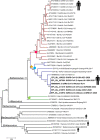An exclusive 42 amino acid signature in pp1ab protein provides insights into the evolutive history of the 2019 novel human-pathogenic coronavirus (SARS-CoV-2)
- PMID: 32167166
- PMCID: PMC7228214
- DOI: 10.1002/jmv.25758
An exclusive 42 amino acid signature in pp1ab protein provides insights into the evolutive history of the 2019 novel human-pathogenic coronavirus (SARS-CoV-2)
Abstract
The city of Wuhan, Hubei province, China, was the origin of a severe pneumonia outbreak in December 2019, attributed to a novel coronavirus (severe acute respiratory syndrome coronavirus 2 [SARS-CoV-2]), causing a total of 2761 deaths and 81109 cases (25 February 2020). SARS-CoV-2 belongs to genus Betacoronavirus, subgenus Sarbecovirus. The polyprotein 1ab (pp1ab) remains unstudied thoroughly since it is similar to other sarbecoviruses. In this short communication, we performed phylogenetic-structural sequence analysis of pp1ab protein of SARS-CoV-2. The analysis showed that the viral pp1ab has not changed in most isolates throughout the outbreak time, but interestingly a deletion of 8 aa in the virulence factor nonstructural protein 1 was found in a virus isolated from a Japanese patient that did not display critical symptoms. While comparing pp1ab protein with other betacoronaviruses, we found a 42 amino acid signature that is only present in SARS-CoV-2 (AS-SCoV2). Members from clade 2 of sarbecoviruses have traces of this signature. The AS-SCoV2 located in the acidic-domain of papain-like protein of SARS-CoV-2 and bat-SL-CoV-RatG13 guided us to suggest that the novel 2019 coronavirus probably emerged by genetic drift from bat-SL-CoV-RaTG13. The implication of this amino acid signature in papain-like protein structure arrangement and function is something worth to be explored.
Keywords: SARS; SARS-CoV-2; Wuhan; coronavirus; pp1ab protein; virus.
© 2020 Wiley Periodicals, Inc.
Conflict of interest statement
The authors declare that there are no conflict of interests.
Figures


References
Publication types
MeSH terms
Substances
Grants and funding
LinkOut - more resources
Full Text Sources
Research Materials
Miscellaneous

